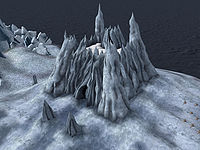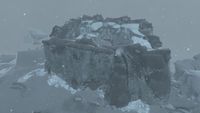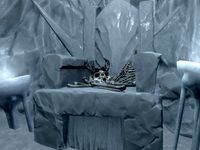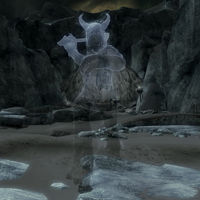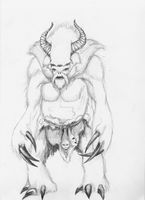Lore:Karstaag
| Karstaag | |||
|---|---|---|---|
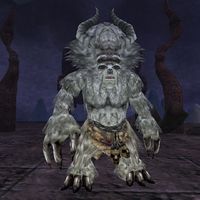 Karstaag in 3E 427 Karstaag in 3E 427
|
|||
| Race | Frost Giant | Gender | Male |
| Died | 3E 427 Mortrag Glacier |
||
| Resided in | Castle Karstaag | ||
| Appears in | Bloodmoon, Dragonborn | ||
Karstaag was a Frost Giant who lived along the northern coast of Solstheim in the late Third Era. He resided in Castle Karstaag, a giant fortress of ice. He employed a large number of rieklings to guard and maintain his castle. The Skaal held an uneasy truce with him.[1] In 3E 427, as part of the Bloodmoon Prophecy, Karstaag was taken from his castle by the Hounds of Hircine to serve as Prey in the Hunter's Game. He and three other champions from the island were brought to a maze beneath the Mortrag Glacier, which served as the hunting ground. When the Hunt began, Karstaag successfully navigated the werewolf-filled maze and made it to the central chamber, where he would face off against an aspect of Hircine to earn his freedom. However, Karstaag was then killed by the Nerevarine, another participant in the Hunt.[2]
Following the Nerevarine's defeat of the Hunter, the glacier collapsed, and Karstaag's remains were buried in the ice. His castle was taken over by the rieklings and fell into ruin, gradually losing its shape. Through unknown means, the majority of Karstaag's skeletal remains were recovered and placed upon his throne.[3] Spell tomes to learn the frost spell "Karstaag's Breath" were in circulation circa 3E 433.[4] His skull was discovered in 4E 201 by the Last Dragonborn, embedded in the wall of a glacial cave. The Dragonborn placed the skull on Karstaag's throne, summoning his angry spirit. Karstaag's ghost was defeated, and temporarily gifted the Dragonborn with the power to summon his spirit to aid in battle.[3]
Contents
Gallery[edit]
Notes[edit]
- Frost Giants are referred to as Karstaags or Karstaag-men in certain obscure texts, implying Karstaag may not simply be a name for an individual.[UOL 1][UOL 2]
See Also[edit]
- For game-specific information, see the Bloodmoon and Dragonborn articles.
References[edit]
- ^ Generic Castle Karstaag dialogue in Morrowind: Bloodmoon
- ^ Hircine's Hunt quest in Morrowind: Bloodmoon
- ^ a b Summoning Karstaag quest in Skyrim: Dragonborn
- ^ Spell Tomes - Karstaag's Breath in Oblivion
Note: The following references are considered to be unofficial sources. They are included to round off this article and may not be authoritative or conclusive.
